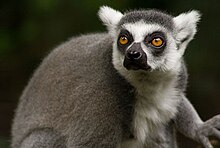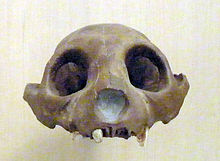Strepsirrhini
| Strepsirrhines[1] Temporal range: Early Eocene - Recent
| |
|---|---|

| |
| Ring-tailed Lemur (Lemur catta) | |
| Scientific classification | |
| Kingdom: | |
| Phylum: | |
| Class: | |
| Order: | |
| Suborder: | Strepsirrhini E. Geoffroy, 1812
|
| Families | |
|
Cheirogaleidae | |
The clade Strepsirrhini (New Latin, from Greek strepsis, "a turning" and the stem of rhis, "nose")[2] is one of the two suborders of primates. Madagascar's only primates (apart from humans) are strepsirrhines, and others can be found in southeast Asia and Africa. The scientist given credit for the name, Étienne Geoffroy Saint-Hilaire, named it for the retention of the rhinarium, a trait characterized as a wet nose, generally present in mammals. In his catalog of features attributed to the Strepsirrhini, he lists "Les narines terminales et sinueuses" (translated "sinuous, twisted or curley nostrils").[3][Note 1] Strepsirrhines are often characterized by their wet nose, but the etymology of their group name refers to the sinuous openings of the rhinarium's nostrils.
Strepsirrhines are considered by primatologists to have more evolutionarily ancestral features and adaptations than their haplorrhine ("dry-nose", in Greek "simple nose") cousins. Their moist nose is connected to the upper lip, which is connected to the gum, giving them a limit to the facial expressions they can manage. Their brain to body ratio tends to be smaller, indicating a lower intelligence. Their brain's olfactory lobes are larger, lending to the notion that they have a stronger reliance on smell. Their snouts are generally elongated, giving them a dog-like appearance, although this is true of some monkeys, too. Strepsirrhines have a postorbital bar, unlike haplorrhines. The strepsirrhines have also retained the ability to enzymatically manufacture vitamin C, which has been lost by all the haplorrhines, including the Tarsiidae.[4]
With the exception of the Aye-aye, all strepsirrhines have a toothcomb—tightly clustered incisors and canine teeth—that is used for grooming. Another grooming adaptation is a toilet-claw on the second toe of all strepsirrhines, while the big toe is widely separated from the others allowing a vise-like grip for locomotion.
About 75% of species are nocturnal and all of these have a tapetum, a shiny, reflective layer in the back of their eyes, although several diurnal species like the Ring-tailed Lemur have it as well. Many of the nocturnal species also have very sensitive hearing and ears they can move independently, allowing them to capture sounds even better.
Strepsirrhine reproduction differs greatly from haplorrhine reproduction. Instead of an individual cycle, strepsirrhines have a breeding season. They also have a litter of offspring and the females have a Y-shaped (bicornate) uterus and multiple sets of nipples.
Classification and evolution

The suborder Strepsirrhini is composed of seven families split into two groups. The first group is the infraorder Lemuriformes, five families of primates typically called lemurs. The other two families are split with the lorises, pottos and the galagos in the infraorder Lorisiformes.
As recently as 2005, the Aye-aye was tentatively placed in its own infraorder (Chiromyiformes). It was uncertain whether this unique primate split off from the ancestral strepsirrhine line before the lemurs and lorises, or after. If the Aye-aye represents a group that is ancestral to all the rest of Strepsirrhini, then it evolved away from the strepsirrhine line between 63 million years ago (mya) (when the strepsirrhines split from the primitive primate line) and 50 mya (the lemur/loris split). If Chiromyiformes is to be considered as the sister only to the lemurs, then it must have evolved after the lemur/loris split 50 mya. In 2008, the Aye-aye and its family, Daubentonia, were placed back in infraorder Lemuriformes, making it the fifth lemur family.[5] Molecular research had shown that Aye-ayes were basal to the lemuriform clade.[6]
Early classification schemes broke the Primate order into the suborders Prosimii (prosimians) and Anthropoidea (simians - monkeys and apes). However, the prosimian tarsiers have been shown to be more closely related to the simians, and so it has been joined with the simians. Prosimii are now renamed Strepsirrhini, and Anthropoidea are now renamed Haplorrhini. Other classifications split Strepsirrhini directly into four superfamilies: Daubentonioidea, Lemuroidea, Loroidea (including Cheirogaleidae) and Indroidea. However, significant evidence suggests that Cheirogaleidae is not related to the lorises, and that Indridae is sister-group to Lemuridae.
The strepsirrhine phylogeny has also been elucidated by retrotransposon presence/absence data.
The adapids are an extinct polyphyletic grouping that were most certainly prosimians and closely related to the strepsirrhines. The omomyids are another extinct group of prosmians but they are believed to be haplorrhines, closely related to the tarsiers, but an outgroup to the rest of the haplorrhines.
As of 2010, there are 125 species of extant strepsirrhine primates, over three-quarters of which are lemurs from Madagascar.[5][7][8]
- Order Primates
- Suborder Strepsirrhini: non-tarsier prosimians
- Infraorder Lemuriformes
- Family Cheirogaleidae: dwarf and mouse lemurs (30 species)
- Family Daubentoniidae: Aye-aye (1 species)
- Family Lemuridae: lemurs (22 species)
- Family Lepilemuridae: sportive lemurs (25 species)
- Family Indriidae: woolly lemurs and allies (19 species)
- Infraorder Lorisiformes
- Infraorder Lemuriformes
- Suborder Haplorrhini: tarsiers, monkeys and apes
- Suborder Strepsirrhini: non-tarsier prosimians
Notes
- ^ Some confuse the comb-shaped lower incisors with the nostrils to arrive at "comb-shaped" and some confuse the nostrils with the nose and strepsis with strephein, "to bend ot turn" to arrive at "bent nose." The nose is not bent nor the nostrils comb-shaped, but the nostrils of a rhinarium do generally feature sinuous openings.
References
- ^ Groves, C. P. (2005). "Strepsirrhini". In Wilson, D. E.; Reeder, D. M. (eds.). Mammal Species of the World: A Taxonomic and Geographic Reference (3rd ed.). Baltimore: Johns Hopkins University Press. pp. 111–127. ISBN 0-801-88221-4. OCLC 62265494.
- ^ "strepsi-". Webster's Third New International Dictionary (Unadbridged ed.). Encyclopedia Britannica, Inc. 1986.
- ^ Saint-Hilaire, E. Geoffroy (1812). "Suite au tableau de quadrumanes. Seconde famille. Lemuriens. Strepsirrini". Annales du Muséum d'Histoire naturelle. 19. Paris: 156–170.
- ^ Attention: This template ({{cite doi}}) is deprecated. To cite the publication identified by doi:10.1002/ajpa.1330730106, please use {{cite journal}} (if it was published in a bona fide academic journal, otherwise {{cite report}} with
|doi=10.1002/ajpa.1330730106instead. - ^ a b Attention: This template ({{cite doi}}) is deprecated. To cite the publication identified by doi:10.1007/s10764-008-9317-y, please use {{cite journal}} (if it was published in a bona fide academic journal, otherwise {{cite report}} with
|doi=10.1007/s10764-008-9317-yinstead. - ^ Attention: This template ({{cite pmid}}) is deprecated. To cite the publication identified by PMID 8952078, please use {{cite journal}} with
|pmid=8952078instead. - ^ Groves, C. P. (2005). "Lorisidae". In Wilson, D. E.; Reeder, D. M. (eds.). Mammal Species of the World: A Taxonomic and Geographic Reference (3rd ed.). Baltimore: Johns Hopkins University Press. ISBN 0-801-88221-4. OCLC 62265494.
- ^ Groves, C. P. (2005). "Galagidae". In Wilson, D. E.; Reeder, D. M. (eds.). Mammal Species of the World: A Taxonomic and Geographic Reference (3rd ed.). Baltimore: Johns Hopkins University Press. ISBN 0-801-88221-4. OCLC 62265494.
Bibliography
- Groves, Colin P. (2001). Primate Taxonomy. Washington: Smithsonian Institution Press. ISBN 1-56098-872-X.
- Attention: This template ({{cite doi}}) is deprecated. To cite the publication identified by doi:10.1073/pnas.0403852101, please use {{cite journal}} (if it was published in a bona fide academic journal, otherwise {{cite report}} with
|doi=10.1073/pnas.0403852101instead. - Shumaker, Robert W.; Beck, Benjamin B. (2003). Primates in Question. Washington: Smithsonian Institution Press. ISBN 1-58834-176-3.
